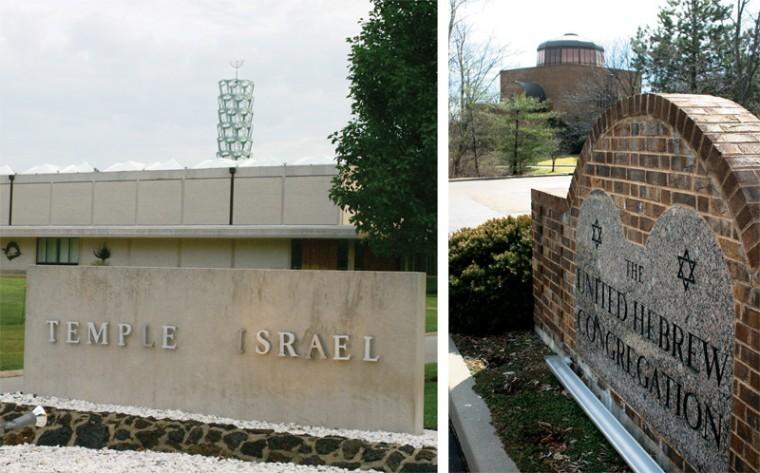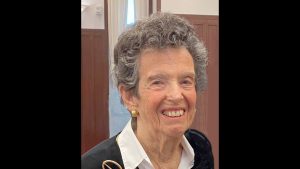TI, UH begin talks on collaboration, potential merger
Published October 22, 2010
In a move that could create the largest Jewish house of worship in the St. Louis area, Temple Israel and United Hebrew Congregation have opened discussions on a possible merger between their respective synagogues.
“The congregations are now engaged in a period of due diligence,” said a joint press release issued Friday afternoon. “If the Board of Trustees of each congregation recommends a merger at the conclusion of the formal talks, final approval will be put to a vote by both congregations.”
The boards of the two Reform temples, with a combined membership of 2,200 families, voted Thursday night to proceed with talks either on a merger or some more extensive form of collaboration. United Hebrew, organized in 1837 was the first synagogue created west of the Mississippi. Founded in 1886, Temple Israel had discussed a possible merger as recently as 2008 with Temple Emanuel but those talks never came to fruition.
This week’s decision was spawned by informal conversations between both congregational presidents in May after a visit by Rabbi Hayim Herring, who led a Jewish Federation-sponsored community summit on the issue of collaboration earlier this year.
Dr. David Weinstein, president of Temple Israel, said the talks were not prompted by financial issues or eliminating duplication but rather a desire to create a more favorable environment for worship and programming.
“We’re not doing this to save money,” he said. “We’re doing it because we believe that combining our resources we can provide better quality services across the spectrum of worship, education and programming to our congregants and the community.”
Weinstein said a potential merger might result in a synagogue able to offer multiple worship services for different groups, expanded adult educational opportunities and higher quality preschool and religious school programs.
“We would love to be not only the Reform congregation that people are coming to in St. Louis but we want to create a new model of a congregation that’s talked about across the nation,” he said.Ed Becker, his counterpart at United Hebrew, concurs. He said the idea for discussions came out of his temple’s strategic planning process, which got underway this spring. Some of that process had focused on collaborative ideas and more effective ways of engaging the community in programming or social justice activities.
“We began to narrow it to what if we were to merge with another congregation. It just sort of grew out of that,” he said. “As we began to look at candidates, obviously we got to TI pretty quickly given where all the Reform congregations are in town.”
The merger possibility comes at a time of flux for both congregations. Temple Israel just hired Amy Feder as senior rabbi this summer while United Hebrew’s senior rabbi Howard Kaplansky is set to assume the title of rabbi emeritus in July of next year. Becker said UH had started the search process for a new rabbi six months ago and had even interviewed candidates but in light of this week’s vote, that committee has suspended its work.
Becker said the next step in the talks would be a new panel with representatives from both congregations to examine the rabbinic leadership question and the convening of “town hall” style meetings for leaders to present their ideas and receive feedback from congregants.
“The other piece is the six or eight committees we would put together on programming, staffing, facilities, ritual, finance and membership,” he said. “This would all run concurrently as best we can until we are ready for a congregational vote.”
Rabbi Feder said the talks would present both organizations with tremendous opportunities. She noted that the response she’d heard from her congregation was “overwhelmingly positive.”
“I expected that my phone would be ringing off the hook with people who are concerned or upset,” she said. “Actually, it’s been just the opposite. Everyone I’ve spoken with has been so excited and said how wonderful it is that the community is open-minded enough to see that to have a solid Jewish future for our congregations we need to think out of the box and talk about ideas that haven’t been talked about for a long time.”
Kaplansky also expressed optimism that the discussions could create some form of collaboration between the two Reform institutions. He stressed it was still an early stage in an open and transparent procedure in which no final decisions have been made.
“We should emphasize that these are talks,” he said. “It’s the beginning of a process of exploration and investigation. It is part of a responsible strategic planning process for both congregations. In a responsible way, we have to react to demographic changes in the St. Louis Jewish community.”
Becker said a timeline on the outcome would be difficult to pin down but he would like to see some type of resolution by next year, particularly by the High Holidays.
Both congregations indicated they had sought guidance from Rabbi David Fine of the Union for Reform Judaism on how to proceed.
Fine could not be reached for comment.
Becker said that if the discussions progress to a merger, a consultant will likely be hired to facilitate the process. His congregation had already been working with a consultant for its own strategic plan, which Becker said was about “80 percent” complete.
“Now that we’ve passed this resolution, we’ve got to get that committee back together and figure out do we finish that plan or just put it on hold,” he said. “We’re not exactly sure what happens with that.”
Weinstein stressed that the talks are in their infancy and many questions, including a location for a possible merged entity, are still on the table and would have to be determined at a future point.
“It might be at either of the two existing facilities with modifications or it could be at a new third site with a new state-of-the-art facility and both of the current facilities could be sold,” he said. “That has not yet been decided and the congregations will play a large role in helping to figure that one out.”
Weinstein pledged an “open and transparent” process. Identical letters went out last week to worshippers at both synagogues informing them of the boards’ decision, each signed by the senior rabbi and president from the relevant congregation.
Becker and Weinstein indicated that the discussions were prompted by three main factors: a shrinking affiliated Jewish population; the situation at each congregation, and the opportunity to do more for congregants.
“There are major demographic changes taking place in the Jewish community,” Weinstein said. “The Jewish population is declining and with the two congregations in various stages of rabbinic transition and strategic planning we saw a lot of complements that would lead to common goals so we thought the fit was good.”
Several area Reform rabbis were unable to be reached for comment by press time. Among those who were reached, reaction varied.
“I think it’s healthy and exciting for organizations, institutions and synagogues in the Jewish community to explore new possibilities of better serving the Jewish community,” said Senior Rabbi James Bennett of Congregation Shaare Emeth.
Shaare Emeth’s rabbi emeritus Jeffrey Stiffman said that the move seemed to reflect a national trend. Whether anything comes of the talks or not, he thought the process was a rewarding one, citing the talks with Temple Emanuel as an example.
“Even having the discussions can be helpful,” he said. “From what I can see, the reaction of the members at Temple Emanuel to the previous discussions with Temple Israel about merging ended up strengthening Temple Emanuel. It woke up their members to the needs that they had. They seem to be a much stronger congregation.”
Rabbi Susan Talve of Central Reform Congregation said that she liked the idea of a diverse Jewish community where residents had many options for worship and no congregation had to be “everything to everybody.”
“I love the fact that there are multiple homes for different groups,” she said.
She said merger talks have happened before and it was best not to jump to conclusions. She also noted that she trusted the leadership in both organizations and that it was important to respect the process and be supportive of decisions that are made.
“We would support anything that’s good for them because what’s good for each congregation is good for the larger community,” she said. “Whatever will make each congregation stronger is better for all of us.”
Rabbi Daniel Plotkin of B’nai El Congregation said he didn’t feel it was appropriate to comment since any changes didn’t impact his temple.
In the TI community, congregant Allan DeSimone, 75, felt the move might bring more interest in the congregation from younger members.
“I think the merger of the two temples would probably be in the best interest of both,” the Creve Coeur resident said. “It would create a single entity and probably allow a lot more input and participation by the various congregants.”
He noted that during a bat mitzvah he’d ushered this weekend, fellow congregants seemed upbeat.
“The impression I got is that people looked quite favorably on the idea,” he said.
Gail Altman, a Chesterfield congregant at UH, said she didn’t favor any potential merger. While she didn’t oppose closer collaboration between two autonomous organizations, she was concerned about where a new combined congregation might be located. The 59-year-old also feared a loss of identity for her congregation.
“Each temple has its own personality,” she said. “That makes up the whole spiritual package.”
Altman joined UH several years ago after a stint at Kol Am. Before that, she’d been with UH since its time on Skinker Boulevard, decades ago. She said conversations about change were healthy but she didn’t want to alter her congregation’s character.
“I’m happy right now where I am,” she said.















